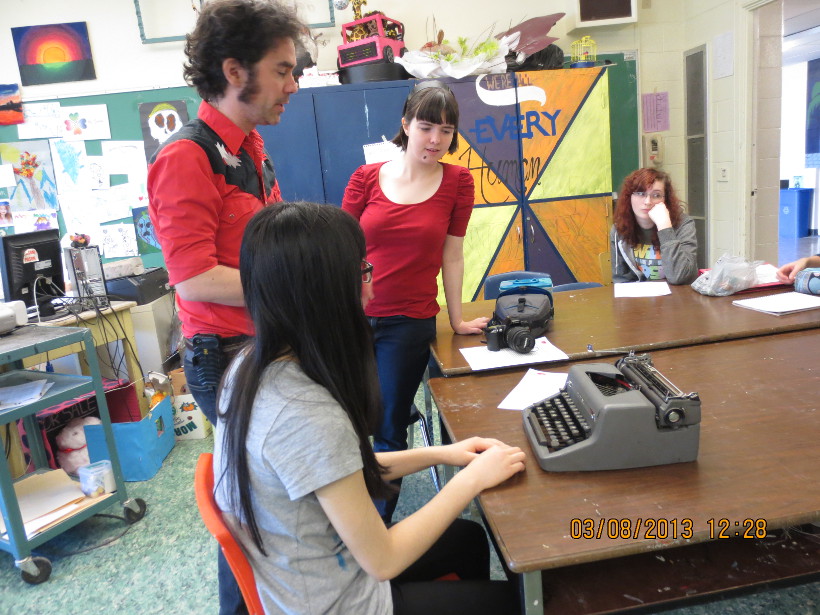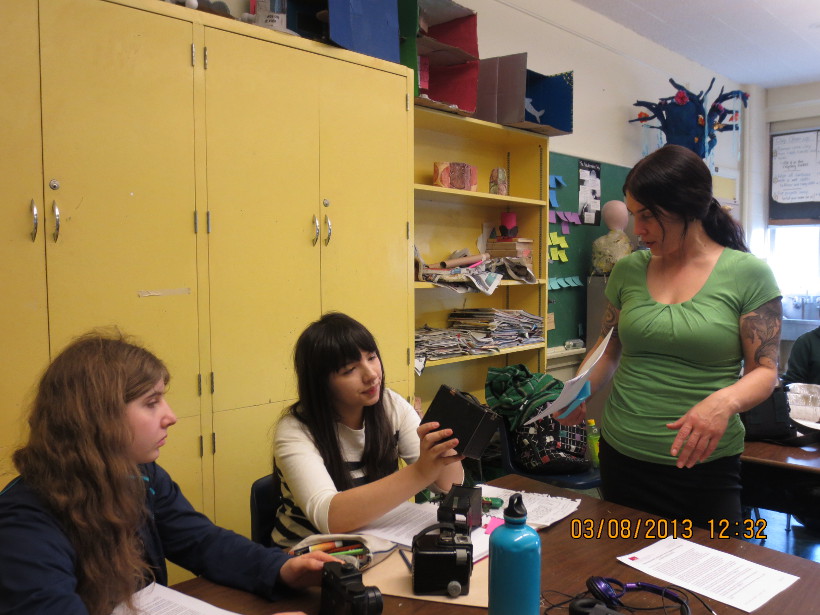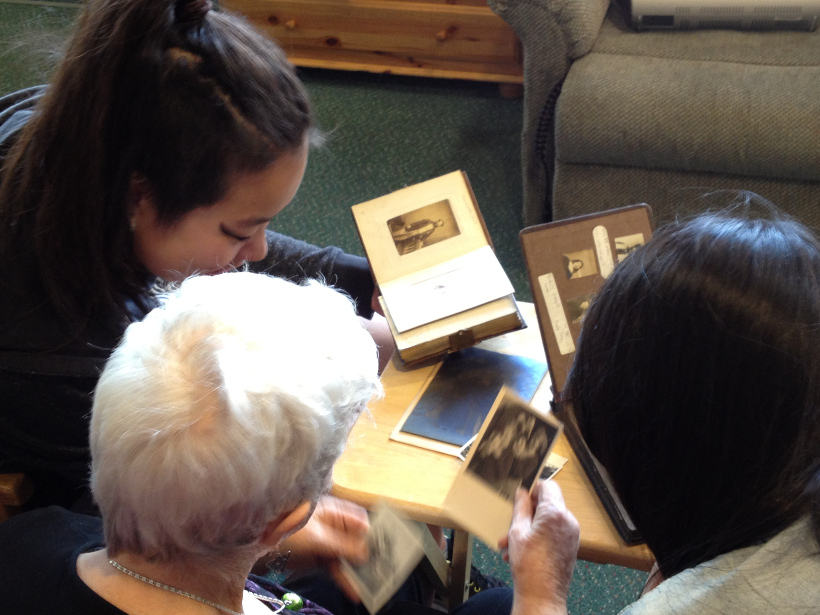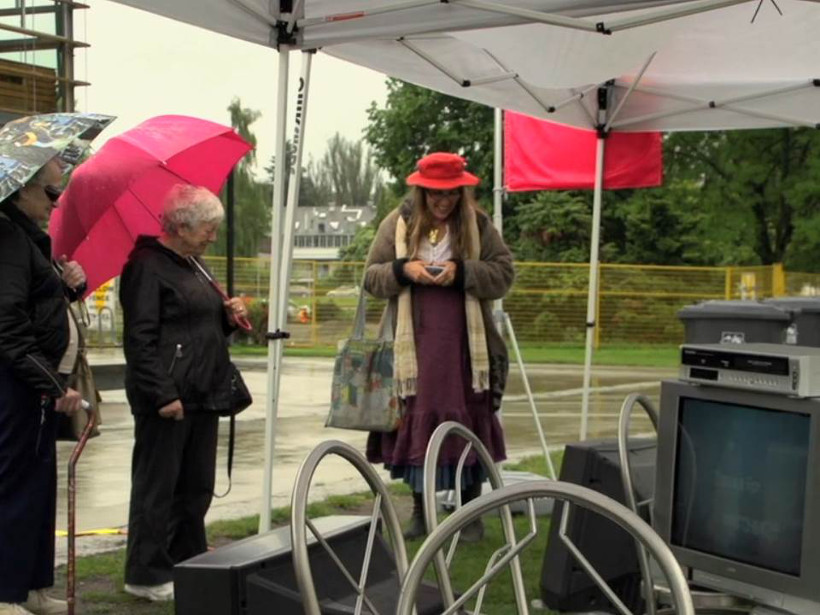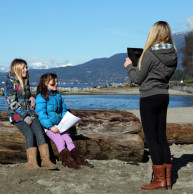Windermere Gr 10 – 12 and Nootka Gr 7
Arts Education
School:
Windermere Secondary and Nootka Elementary, Vancouver, BC
Teachers:
Hank Ferris and Laura Charlotte Treloar
Artist:
Flick Harrison
Class:
Grade 7, Grade 10 – 12
Sources of Inspiration:
Vancouver Biennale Legacy: Echoes at Kitsilano Beach
Overview:
Windermere students were inspired by Echoes in its idea of using object to generate unexpected dialogue. The secondary school students faced their first challenge to source and find new ways to use old equipment (cameras, typewriters). This process unveiled untold old family stories for some students. Through connecting with the local elementary school students, Windermere students reflected on their past and present moment in life. The subsequent visit to the senior centre provided a glimpse into a distant past or future. The final process of compilation of the collected materials was done using the latest technology. Through this project, the students interacted with multiple stages in both human and product life cycles.
BIG IDEAS:
Life Cycles
Guiding Question:
Is it possible to find new meanings and/or un-thought of purpose for objects in state of obsolescence? What can we learn from people in different stages in life?
Curriculum Access:
Digital Media, Photography
Learning Process:
Given the challenge to use old cameras and typewriters for this project, Windermere students travelled back in time to find out how to use these devices and test their quality and usability. They also learnt how to use the latest gadget iPad to create the final video production from stills taken with the old equipment. Then the video was displayed on old televisions. A learning process that bridged the old and new technology.
The project is also about connecting with the local community. The secondary and elementary school students interviewed and took portraits of each other in small groups. The secondary school students visited the seniors and shared their life stories. During that process, the students found out how seniors wanted to be remembered in their portraits. In synopsis, a learning process that focuses on intergenerational interaction.
Student Creations:
A video of portraits and interviews of elementary school students and seniors with written Interview materials for display as a presentation at Kitsilano Beach on top of the original BIG IDEA inspirations, Echoes.
Taking Action:
This project connects the students from Windermere Secondary school within their community. The students acted as leaders and mentors for the elementary students and as good companions and listeners to the senior citizens. The seniors enjoyed an outing to Echoes to see the final video presentation.
Timeline:
Jan
Windermere school representatives attended the Biennale kick off session
Feb
At Windermere Secondary:
- Introduction of BIG IDEA, the Vancouver Biennale and project concept.
- Discussion on portraiture – what makes a good portrait working with old equipment
- Students are asked to source outdated equipment from home or second hand stores – cameras and typewriters that they found compelling. A student brought a camera that her great grandmother owned during WW2.
Mar
- Students formed small groups. They troubleshoot, research and sought help to learn how to work with these old devices.
- Students had to find out where to find film and materials in order to use them. Some equipment were rebuilt, refurbished, or fine tune to meet their needs.
- The secondary students visited their neighbor elementary school to interview the Grade 7 class. The Windermere and Nootka students interview and took portraits of each other.
Apr
- Windermere students visited a senior home in their community to interview and took portraits of the seniors.
- The seniors were asked to bring items that describe or represent their life experiences.
May
- The students created and edited videos from the still images and wrote text to best describe the images.
- The looping videos were installed and shown using old televisions at Echoes site as an exhibition.
Reflections:
Teacher: The students were engaged and took ownership of the project from the start. They really worked hard to get the old equipment to work. Some students found new information about and new connections with their families.
Artist(s): This project was very creatively satisfying. Seeing the students reach out into their personal and family networks and return with old electronic gear, stories about their families’ histories, and an eagerness to share their discoveries, was the entire point of the process but it still felt like a pleasant surprise. The seniors felt very good that young people were interested in their stories.
The logistical chunkiness of letting teenagers work out many issues on their own time and initiative were balanced by that creative satisfaction. There were limitations to juggling not only secondary and primary-school schedules and technology challenges but a narrow window of opportunity with the seniors, but these again led to some incredibly rewarding experiences.
Students: Students made multiple connections between old outdated technology and the evolution of those devices into what is currently available in society. These concepts at first were difficult for students to comprehend but with the introduction of field trips to both their neighborhood elementary school and senior’s home, students were able to bridge the gap between the past, present and future.
Students were amazed by the connections they made with people they normally would not encounter – the younger students and elderly.
Students were amazed by the quality of old technology.
